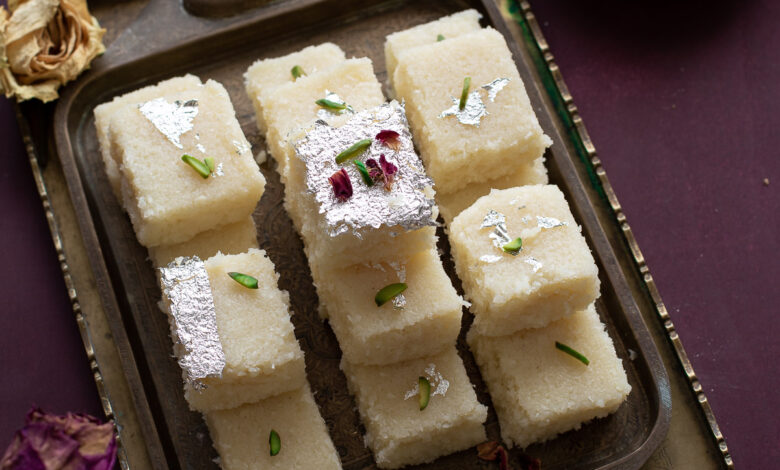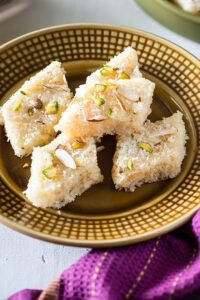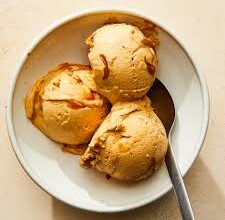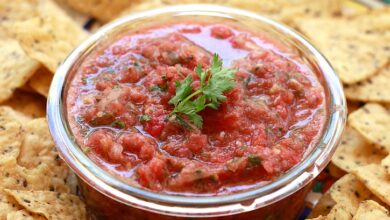Coconut Barfi Recipe
Coconut Barfi Recipe

Coconut Barfi Recipe Introduction:
Coconut Barfi, also spelled as “burfi” or “burfee,” is a traditional Indian sweet that falls under the category of mithai (sweets). The word “barfi” comes from the Persian word “barf,” meaning “snow,” which reflects the sweet’s snowy, white appearance. The base of this treat is made from grated coconut and milk, which are cooked together with sugar to form a dense, fudge-like consistency.
The beauty of Coconut Barfi lies in its simplicity. The basic recipe requires only a few ingredients—grated coconut, sugar, and milk—and can be enhanced with flavorings like cardamom, nuts, and saffron. It’s often garnished with slivers of almonds or cashews for added texture and visual appeal.

Coconut Barfi Recipe Overview:
This simple yet delicious treat captures the essence of traditional Indian sweets, making it a perfect choice for celebrations or a sweet indulgence any time.
Coconut Barfi Recipe Ingredients:
- Fresh Grated Coconut: 2 cups (you can use desiccated coconut if fresh is not available)
- Sugar: 1 cup (adjust to taste)
- Milk: 1 cup (preferably full cream or whole milk; you can also use condensed milk for a richer barfi)
- Ghee (Clarified Butter): 2 tablespoons (for cooking and greasing)
- Cardamom Powder: 1/2 teaspoon (optional, for flavor)
- Chopped Nuts: 1/4 cup (such as almonds, cashews, or pistachios; optional, for garnish)
- Saffron: A few strands (optional, for color and flavor)
- Additional Flavorings: (optional) A small amount of rose water or vanilla extract, if desired
Coconut Barfi Recipe Ingredient Tips:
- Grated Coconut:
- Fresh Grated Coconut: Use freshly grated coconut for the best texture and flavor. If using fresh coconut, make sure to grate it finely to ensure even cooking.
- Desiccated Coconut: If fresh coconut isn’t available, desiccated coconut is a good substitute. Use unsweetened desiccated coconut for best results. If it seems too dry, you can lightly toast it in a pan before using.
- Sugar:
- Adjust Sweetness: You can adjust the amount of sugar based on your preference. If using condensed milk, you might want to reduce or eliminate additional sugar.
- Type of Sugar: Regular granulated sugar works well, but you can also use brown sugar for a slightly different flavor.
- Milk:
- Full Cream or Whole Milk: These types of milk provide a richer flavor and creamier texture. If using low-fat or skim milk, you might need to adjust the cooking time or add a bit more ghee to compensate for the lower fat content.
- Condensed Milk: For a richer, sweeter barfi, you can use condensed milk in place of regular milk and sugar. Just reduce or omit the additional sugar.
- Ghee (Clarified Butter):
- Quality: Use high-quality ghee for the best flavor. It adds a rich, nutty taste to the barfi.
- Substitute: If ghee is not available, you can use unsalted butter as a substitute, though the flavor might be slightly different.
- Cardamom Powder:
- Freshly Ground: For the best flavor, use freshly ground cardamom. You can grind whole cardamom pods yourself or use pre-ground cardamom from a reputable brand.
- Quantity: Adjust the amount to taste, as cardamom can be quite strong. Start with a small amount and add more if desired.
- Chopped Nuts:
- Type and Freshness: Use fresh, unsalted nuts. Toasting the nuts lightly before adding them can enhance their flavor.
- Garnishing: Garnish the barfi with nuts after it has set but while it’s still slightly warm to ensure they stick.
- Saffron:
- Usage: A small pinch of saffron adds a beautiful color and subtle flavor. Soak saffron strands in a tablespoon of warm milk for better color and flavor release before adding them to the mixture.
- Optional: Saffron is optional but adds a touch of luxury and traditional flavor.
- Additional Flavorings:
- Rose Water or Vanilla Extract: If desired, you can add a small amount of rose water or vanilla extract for additional flavor. Use sparingly to avoid overpowering the coconut flavor.
General Tips:
- Consistency Check: Ensure the mixture cooks until it thickens properly and starts to leave the sides of the pan. This ensures the barfi will set correctly.
- Greasing the Pan: Grease the tray or plate with ghee to prevent the barfi from sticking.
- Cooling: Allow the barfi to cool completely before cutting to achieve clean, neat pieces.
These tips should help you achieve a delicious and perfectly textured Coconut Barfi.
Coconut Barfi Recipe Equipment Needed:
- Non-Stick Pan or Heavy-Bottomed Pan:
- Purpose: To cook the coconut mixture evenly without burning. A non-stick or heavy-bottomed pan prevents sticking and ensures even heat distribution.
- Spatula or Wooden Spoon:
- Purpose: For stirring the mixture continuously as it cooks to prevent it from sticking to the pan and to ensure even cooking.
- Grater or Food Processor:
- Purpose: To grate fresh coconut if you’re using it. A food processor can make this task quicker and more consistent.
- Measuring Cups and Spoons:
- Purpose: For accurately measuring ingredients like sugar, milk, and coconut.
- Mixing Bowl:
- Purpose: For preparing any additional ingredients or combining flavorings before adding them to the pan.
- Tray or Plate:
- Purpose: To set the cooked mixture and allow it to cool. Grease it with ghee to prevent sticking.
- Knife:
- Purpose: For cutting the barfi into pieces once it has set.
- Greaseproof Paper or Parchment Paper (Optional):
- Purpose: To line the tray or plate for easier removal and cleaning.
Optional Equipment
- Candy Thermometer:
- Purpose: To monitor the temperature of the mixture if you want to ensure it reaches a specific consistency. This is usually not necessary for Coconut Barfi but can be helpful.
- Small Sifter:
- Purpose: To sift cardamom powder or other dry flavorings to ensure they are evenly distributed.
- Mortar and Pestle:
- Purpose: For grinding cardamom seeds if you are using whole pods.
- Silicone Spatula:
- Purpose: To scrape down the sides of the pan and ensure that no mixture is left behind.
- Saffron Infuser:
- Purpose: For soaking saffron strands in milk to evenly distribute the flavor and color.
Having these tools on hand will help ensure that your Coconut Barfi turns out well and that the cooking process is smooth and efficient.
Coconut Barfi Recipe Step-by-Step Instructions:
- Prepare Your Ingredients:
- If using fresh coconut, grate it finely. If using desiccated coconut, measure out the required amount.
- Chop the nuts if using and soak saffron strands in a tablespoon of warm milk if adding.
- Heat the Ghee:
- In a non-stick or heavy-bottomed pan, heat 2 tablespoons of ghee over medium heat.
- Toast the Coconut:
- Add the grated coconut to the pan and sauté for 2-3 minutes, stirring constantly, until it becomes fragrant and lightly toasted.
- Add Milk and Sugar:
- Pour in 1 cup of milk (or condensed milk if using) and 1 cup of sugar.
- Stir the mixture well to combine.
- Cook the Mixture:
- Continue cooking the mixture over medium heat, stirring frequently. The mixture will gradually thicken. This can take about 10-15 minutes.
- If using saffron, add it to the mixture once it starts thickening.
- Add Flavorings:
- Once the mixture is thick and starts to pull away from the sides of the pan, stir in 1/2 teaspoon of cardamom powder and any additional flavorings like rose water or vanilla extract if desired.
- Continue cooking for another 2-3 minutes until the mixture becomes dense and starts to leave the sides of the pan.
- Transfer to Tray:
- Grease a tray or plate with a little ghee to prevent sticking.
- Transfer the thickened coconut mixture onto the tray and spread it evenly using a spatula or the back of a spoon.
- Garnish (Optional):
- While the mixture is still warm, press the chopped nuts into the surface for added texture and visual appeal.
- Cool and Set:
- Allow the barfi to cool completely at room temperature. This will help it set and become firm.
- Once cooled, it should be firm enough to cut into pieces.
- Cut and Serve:
- Use a knife to cut the barfi into squares or diamond shapes.
- Serve at room temperature or store in an airtight container.
- Storage:
- Coconut Barfi can be stored in an airtight container at room temperature for up to a week. It can also be refrigerated for longer shelf life.
Enjoy your homemade Coconut Barfi! It’s a delightful treat that combines the rich flavors of coconut with the sweetness of sugar and the warmth of cardamom.
Coconut Barfi Recipe Tips and Tricks:
- Choosing Coconut:
- Fresh Coconut: If using fresh coconut, make sure it is well-grated and not too coarse. It should be moist but not overly wet.
- Desiccated Coconut: If using desiccated coconut, lightly toast it before use if it feels too dry. This helps in improving texture and flavor.
- Milk Consistency:
- Full Cream Milk: Use full cream or whole milk for a richer texture. If using skim or low-fat milk, you may need to cook the mixture a bit longer or add a little extra ghee to compensate for the reduced fat content.
- Condensed Milk: If using condensed milk, reduce or omit the additional sugar as condensed milk is already sweetened.
- Cooking Technique:
- Medium Heat: Cook the mixture over medium heat to avoid burning. Stir frequently to prevent sticking and ensure even cooking.
- Thickening Point: Be patient while cooking. The mixture is ready when it starts to pull away from the sides of the pan and has a dense, fudgy consistency.
- Adding Flavorings:
- Cardamom: Use freshly ground cardamom for the best flavor. Start with a small amount and adjust according to taste.
- Saffron: Soak saffron strands in a bit of warm milk before adding them to ensure the flavor and color are evenly distributed.
- Additional Flavorings: If adding rose water or vanilla extract, use sparingly to enhance the flavor without overpowering the coconut.
- Setting the Barfi:
- Greasing the Tray: Grease the tray or plate with ghee to make it easier to remove the barfi once it has set.
- Cooling: Allow the barfi to cool completely before cutting. This helps it set properly and makes cutting into neat pieces easier.
- Cutting and Serving:
- Sharp Knife: Use a sharp knife to cut the barfi into squares or diamond shapes for clean cuts.
- Garnishing: Press nuts or other garnishes gently into the surface while the barfi is still slightly warm so they adhere well.
- Storage:
- Airtight Container: Store the barfi in an airtight container to keep it fresh and prevent it from drying out.
- Room Temperature: It can be kept at room temperature for up to a week. For longer storage, refrigerate it, though it may become firmer.
- Texture Adjustments:
- Dry Mixture: If the mixture seems too dry and crumbly, add a bit more milk or ghee.
- Wet Mixture: If it’s too wet, cook it for a bit longer to thicken it further. Ensure it doesn’t burn during this process.
Serving Suggestions:
- Garnish with Nuts:
- Chopped Nuts: Top the barfi with slivers of almonds, cashews, or pistachios for added texture and flavor.
- Whole Nuts: Place whole nuts on top while the barfi is still slightly warm to make it visually appealing.
- Accompaniments:
- Tea or Coffee: Serve Coconut Barfi with a cup of tea or coffee for a satisfying sweet treat alongside your beverage.
- Milk or Lassi: Pair with a glass of milk or traditional Indian lassi (a yogurt-based drink) for a refreshing combination.
- Dessert Platter:
- Mixed Sweets: Include Coconut Barfi on a platter with other Indian sweets like Gulab Jamun, Jalebi, or Kaju Katli for a diverse dessert spread.
- Fruit: Serve alongside fresh fruit like mangoes, pomegranates, or berries for a balanced dessert experience.
- Presentation:
- Decorative Platter: Arrange the cut pieces of barfi on a decorative platter or tray. Garnish with edible flowers or additional nuts for a festive look.
- Paper Liners: Place each piece of barfi in a small paper liner or cupcake wrapper for an elegant presentation, especially if serving at a party or gathering.
- Gift Ideas:
- Gift Boxes: Pack Coconut Barfi in decorative gift boxes or tins to give as gifts for festivals, birthdays, or special occasions.
- Personalized Packaging: Wrap the barfi in colorful cellophane or fabric with a ribbon for a personalized touch.
- Layered Desserts:
- Layered Treats: Use Coconut Barfi as a layer in desserts like trifles or parfaits, alternating with fruits or other sweet layers.
- Ice Cream Topping: Crumble Coconut Barfi over vanilla or coconut-flavored ice cream for a unique topping.
- Cold or Room Temperature:
- Chilled: Refrigerate Coconut Barfi before serving to enjoy a firmer texture, especially if you prefer it cold.
- Room Temperature: Serve at room temperature to appreciate its full flavor and slightly soft texture.
- Festive Serving:
- Special Occasions: Serve Coconut Barfi during festivals like Diwali, Holi, or Raksha Bandhan as part of a traditional sweet spread.
- Celebrations: Include it in celebrations such as weddings or anniversaries for a touch of Indian tradition.
FAQs:
- Can I use desiccated coconut instead of fresh grated coconut?
- Answer: Yes, you can use desiccated coconut as a substitute for fresh grated coconut. If desiccated coconut feels too dry, lightly toast it in a pan before using to enhance its flavor and texture.
- Can I use condensed milk instead of regular milk and sugar?
- Answer: Yes, you can use condensed milk for a richer and sweeter barfi. If using condensed milk, reduce or omit the additional sugar as condensed milk is already sweetened. Adjust the quantity of milk accordingly to maintain the right consistency.
- How do I know when the mixture is ready to set?
- Answer: The mixture is ready when it thickens significantly and starts to pull away from the sides of the pan, forming a dense, fudgy consistency. It should also leave the sides of the pan clean when stirred. A test you can do is to take a small amount of the mixture and let it cool; it should hold its shape when pressed.
- Can I make Coconut Barfi without ghee?
- Answer: Ghee adds a rich flavor to Coconut Barfi, but you can substitute it with unsalted butter if ghee is not available. Keep in mind that the flavor may be slightly different.
- How should I store Coconut Barfi?
- Answer: Store Coconut Barfi in an airtight container at room temperature for up to a week. For longer storage, you can refrigerate it. Refrigeration may make the barfi firmer, so allow it to come to room temperature before serving for a softer texture.





